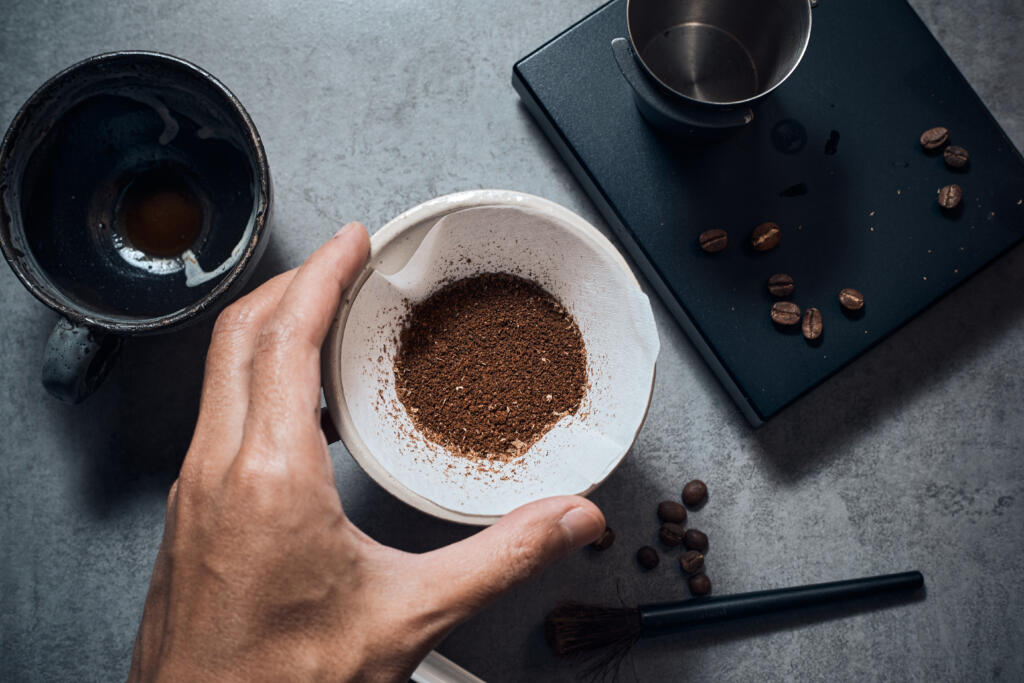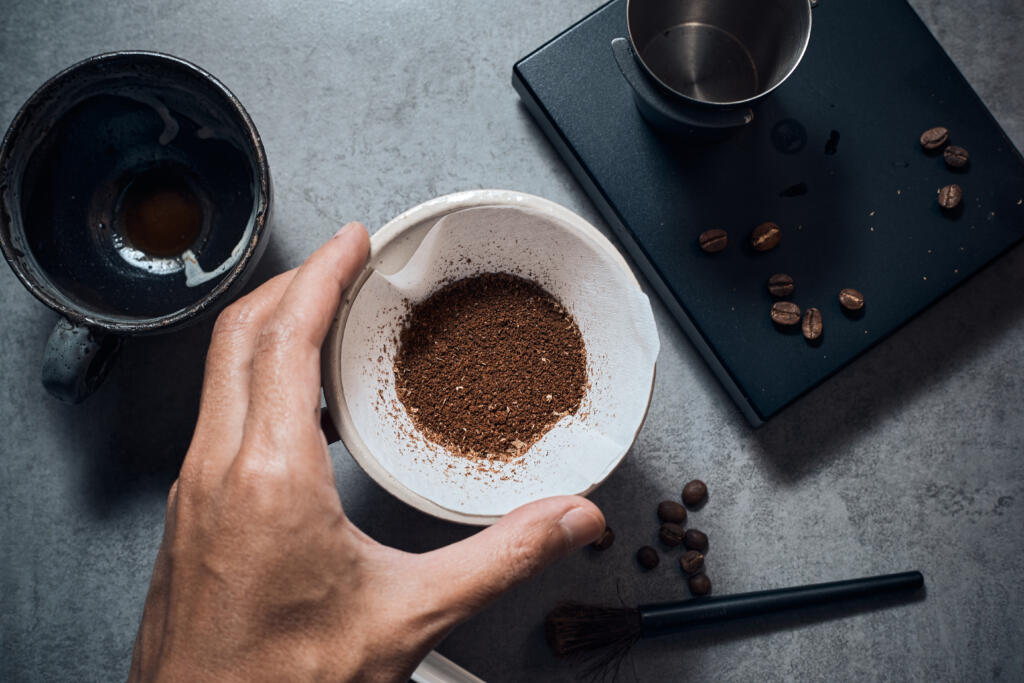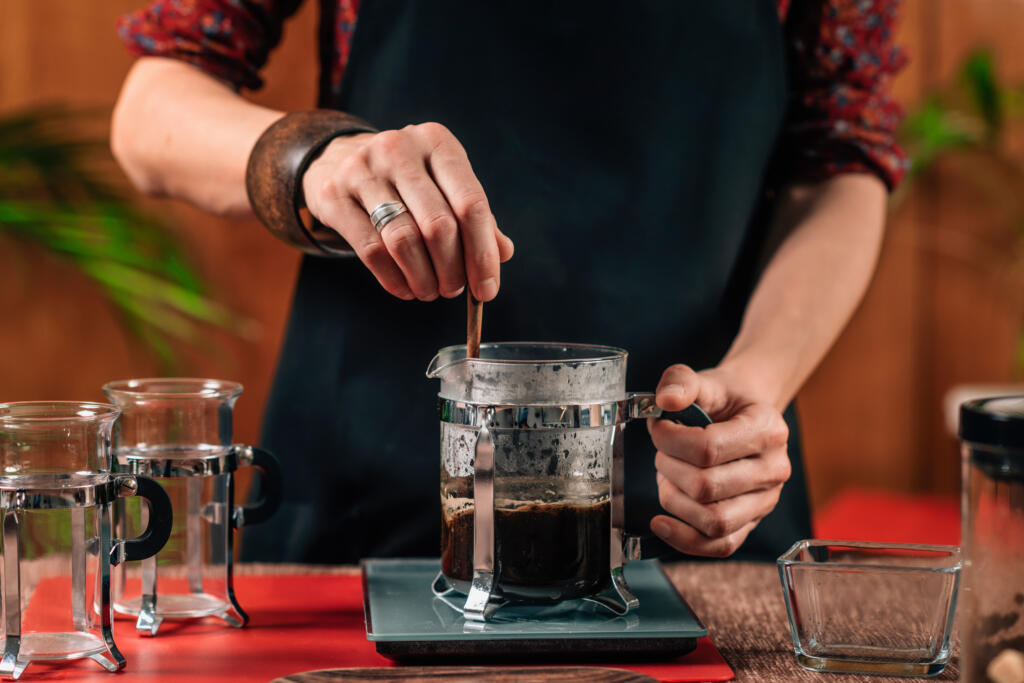Brewing the perfect cup of coffee requires precise measurements, and failure can result in a bitter or weak drink. If you’re looking for an easy way to ensure your water-to-coffee ratio is accurate, this blog post is for you!
We’ll explore how to calculate water loss during brewing and provide tips on achieving the perfect cup of joe every time.

What is the Default Coffee-to-Water Ratio?
The default coffee-to-water ratio is the “Golden Ratio” — one to two tablespoons of ground coffee for every six ounces of water. This ratio can be adjusted depending on the brewing method, with the Chemex coffee brewing method typically using a 1 to 17 ratio.
It’s important to use this guideline when brewing coffee, as it helps to ensure that the right amount of coffee is used about the water volume. Getting this ratio right can make a difference in the taste and quality of your cup of coffee.
How to Calculate Water Loss During Brewing Coffee
Calculating water loss during brewing coffee is crucial for ensuring the perfect cup. To determine the amount of water lost, begin by measuring the initial volume of water used in the brewing process. Then measure the temperature of your water before and after brewing to calculate the difference in volume.
You can also measure the weight of your coffee grounds before and after brewing and calculate the percentage of water loss.
Additionally, there are a few tips to reduce water loss during brewing, such as using the right temperature, keeping the brewing time short, checking for leaks in your equipment, and optimizing your grind size.
Determine the initial water volume
To determine the initial water volume, you will need to measure the water you use in your brewing process.
This can be done by filling a measuring cup or another container with the desired amount of water, then pouring it into the coffee maker. If a scale is available, you can also measure the weight of the water and use that to determine the volume.
It is important to use cold, filtered water for brewing, as this will help to ensure an accurate measurement. Once you have measured your water volume, you can set up your coffee maker and grind your beans.
Measure the temperature of the water before and after brewing
It is essential to measure the temperature of the water before and after brewing coffee. It is important to maintain a temperature range of 195°F to 205°F for optimal flavor extraction. If this temperature range is not maintained, you risk diminishing extraction and losing taste.
To measure the temperature, use a thermometer or a brewer with cup lines or indicators. When measuring, remember that some water is lost to evaporation in certain brewers. This can be reduced by covering the vessel very well to reduce temperature loss when you pour your water.
Additionally, it is important to keep the brewing time short and optimize your grind size to reduce water loss during brewing.
Subtract the weight of the coffee grounds
Before you can calculate the water loss during your brewing process, you need to determine the weight of the coffee grounds. To do this, measure the weight of the grounds before brewing and then subtract that from the total weight of the brewed coffee.
This will give you the exact amount of water lost during brewing. Remember that certain brewing methods, such as pour-over, can result in more water being absorbed by the bed of coffee grounds above the filter.
Additionally, some water is always lost to evaporation in certain brewing methods.
Calculate the water loss
By using an initial water volume measurement, the weight of the brewed coffee, and subtracting the weight of the coffee grounds, you can accurately calculate the water loss. Factors such as grind size, brew method, and the quality of beans used can all affect the amount of water lost during brewing.
To ensure optimal results, use the right amount of coffee grounds, choose the right brewing method, keep an eye on your water temperature, and check for any leaks in your setup.
Tips for Reducing Water Loss During Brewing

Reducing water loss during brewing is important to making a great cup of coffee.
Use the Right Amount of Coffee Grounds
Using the right coffee grounds ensures you don’t experience water loss during brewing. The ideal ratio of coffee to water is 1:15, which means you will need 15 grams of water for every gram of coffee.
This ratio can be adjusted slightly depending on the grind size, the origin and quality of the beans, and the brewing method you choose.
For example, if you’re using coarser grounds and a pour-over method, you might use a ratio closer to 1:12 for a stronger cup. You can minimize water loss during brewing by consistently measuring your coffee-to-water ratio and adjusting it accordingly.
Optimize your grind size
The finer the grind size, the more surface area is exposed to water, resulting in more extraction and increased flavor. However, a too-fine grind can clog the filter and make it difficult for water to pass through, leading to over-extraction and an overly bitter cup of coffee.
If you’re using a Chemex brewer, aim for a medium-coarse grind size with a texture like a sea salt. If you’re using a different brewer, experiment with different grind sizes to find the best balance.
Choose the Right Brewing Method
Different methods require different ratios of coffee to water, which can drastically affect the final product’s taste.
For example, French Press coffee requires a higher ratio of coffee than pour-over coffee methods. Additionally, the grind size should be adjusted accordingly to ensure optimal brewing time.
Furthermore, different types of water may be used depending on the roast and origin of the beans – softer water for darker roasts and harder water for lighter and brighter coffees.
Use the right water temperature
It is important to use the right water temperature when brewing coffee. The ideal temperature range is between 195 and 205 degrees Fahrenheit. This temperature range ensures that the water can extract all flavors and substances from the coffee grounds.
To get the right temperature, preheat your brewing vessel, so you don’t lose heat when you pour in the water. You can also check the temperature of your water before and after brewing to calculate water loss and adjust accordingly.
Keep the brewing time short
Keeping the brewing time short is an important step in reducing water loss during the brewing process. The temperature of the water can have a significant effect on how much water is lost, and for that reason, it is important to keep the brewing time as short as possible.
To make sure your coffee is properly extracted, it is recommended to keep the brewing time between 4-5 minutes. This will ensure that the water has enough time to extract the flavor from the coffee grounds without losing too much of it in evaporation.
Check for water leaks in the equipment
Checking for water leaks in brewing equipment is important, as water can be lost at four points:
- grain absorption
- dead spaces in brewing equipment
- evaporation during the boil
- and trub loss.
To ensure that your coffee maker is leak-free, it is essential to check for water leaks using a thermometer to check the water temperature. Anything lower than 195 degrees Fahrenheit will indicate a water leak.

Common Mistakes to Avoid When Calculating Coffee to Water Ratio
Getting the right water-to-coffee ratio is essential for a successful cup. However, a few common mistakes can easily be avoided when calculating the ratio.
Use the Right Measurement Tool
It is important to use the right measurement tool when calculating coffee to water ratio. The ratio may vary depending on your coffee brewing method, but using the wrong tool can lead to an improperly brewed cup.
Measuring spoons or cups is often inaccurate in measuring the proper amount of coffee grounds, so it is recommended that you use a kitchen scale for the most accurate results. Additionally, digital scales allow you to measure in grams instead of tablespoons, giving you more precise results.
For example, if you are making a French press and need two tablespoons of coffee grounds, you’ll want to ensure you have exact measurements and not over or under-estimate.
Don’t Forget to Account for Evaporation
When calculating the coffee-to-water ratio for brewing coffee, it’s important to factor in evaporation. A good rule of thumb is to add an extra 20-30% of water to your mixture to accommodate the water that will evaporate during the brewing process.
This additional water will ensure your desired coffee strength without bitterness or sourness. Additionally, suppose you are using a pour-over method. In that case, allowing the water to cool slightly before pouring it over the grounds is important to avoid scorching them.
Check the Grind Size of Your Coffee Beans
The grind size can affect the flavor of your coffee and will impact the amount of time it takes for the water to pass through the grounds. Using too coarse of a grind can result in weak, under-extracted coffee, while too fine of a grind can lead to over-extracted, bitter-tasting coffee.
We recommend a medium-fine grind size for most pour-over methods. Additionally, using old beans will produce a more bland and sometimes dull-tasting coffee.
Conclusion
In conclusion, calculating water loss during coffee brewing is important to consider when making coffee. With the right water temperature, a short brewing time, a correctly-sized grind, and no leaks in the equipment, you can reduce water loss during the process.
Additionally, measuring the initial water volume, temperature before and after brewing, the weight of coffee grounds before and after brewing, and the amount of water used can help you accurately calculate the percentage of water lost during the process.
Disclaimer: This post contains affiliate links, which means I may receive a small commission, at no extra cost to you, if you make a purchase using these links. Remember to support us by purchasing through the Amazon/Walmart/Impact Radius links provided. Last update on 2024-04-19 / Affiliate links / Images from Amazon Product Advertising API
Disclosure: No compensation or free products were received in exchange for writing this review.

Editorial Staff
The editorial staff at Crazy Coffee Crave is a team of coffee enthusiasts & Baristas who enjoy the one thing we all think about as soon as we get up in the morning. Trusted by thousands of readers worldwide.






